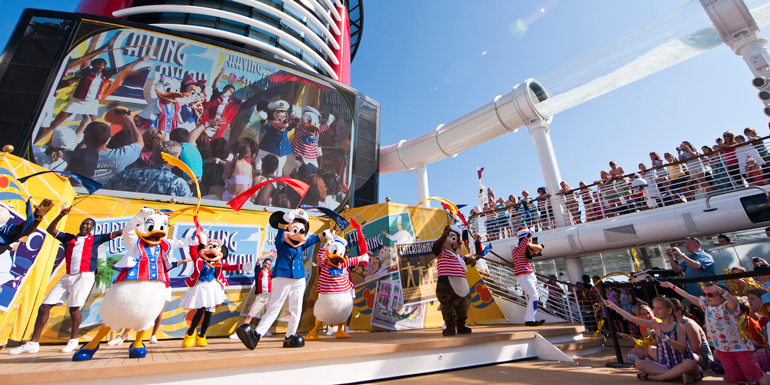Cruise ships have a lot to offer families, from children’s programs and pools to family-friendly restaurants. So, are they safe for kids? This is something that many parents wonder before booking a trip at sea.
In this article, we’ll explore the safety of cruises for children.
- The Reasons Why Cruises Are Safe for Kids
- Potentially Dangerous Areas for Kids
- How to Keep Your Children Safe on a Cruise
- Watch Your Children at All Times
- Understand the Protocol for the Children’s Area
- Be Vigilant Around Potentially Dangerous Areas
- Make Sure There Is Emergency Contact Information Posted Near Your Kids
- Know How to Contact the Medical Office
- Take Enough Prescription Medication
- Ensure Your Children Wash Their Hands Frequently
The Reasons Why Cruises Are Safe for Kids
If you’ve never taken a cruise with your children, you might be wondering if they are safe for kids. The answer is yes. In general, cruises are very safe for kids of all ages.
Here are some of the reasons why.
Cruises Have an Incentive to Make Things Safe
Cruise lines spend a lot of money on safety and security systems to keep passengers safe. They want to avoid losing business because of safety problems.
They also try to protect children from strangers, prohibiting adults from sharing staterooms with children who aren’t their own without permission.
Cruises Have Health Standards
Cruises are supposed to be fun for the whole family, but that doesn’t mean people don’t get sick while they’re at sea. That’s why cruise ships have a set of health standards for food preparation to minimize the risk of kids getting sick.
Of course, the best way to prevent your kids from getting sick in these situations is through careful hand-washing, which you should do regularly when cruising anyway.
Cruises Have Child-Proofing Standards
A lot of people wonder if cruise ships are childproof. The answer is yes.
Since children can’t swim without adult supervision, most cruises require that you put an individual life vest on your kids at all times when they’re in pools or other areas where there could be water.
Crew members also take their jobs seriously and look out for your protection. There will most likely be a lifeguard available at any swimming areas and staff to keep an eye out. This doesn’t mean, however, that you should leave your kids unsupervised.
Potentially Dangerous Areas for Kids
While cruises are usually safe for kids, that doesn’t mean that parents can leave their children (especially the young ones) to roam around independently. Parents should be aware if their cruise has any of the following amenities as these can be some potentially dangerous areas.
Pool Area
The pool area is probably one of the most common areas where kids get hurt on cruise ships, so it’s vital to keep an eye on your children. If there’s no lifeguard present and you’re not observing them, your little ones might be at risk of drowning. Even if there is a lifeguard, kids can fall into pools or be hit by other swimmers.
Another danger of pools or swimming areas is the wet concrete. If kids start running, they may slip and fall and could get scratched up or break a bone.
Stairways
Kids under five should not go up or downstairs without an adult present, but older children might still pose a risk to themselves if they don’t use the stairs carefully.
Parents should teach their kids how to safely climb and descend the stairs to avoid accidents such as tripping and falling. These injuries can occur on cruise ships because of the ship’s movement and the high number of older passengers.
Cafeteria Areas
If you’re on a cruise with kids, they probably want to eat. Ensure when your kids go to eat that the dining area has high chairs available and you supervise your children at all times.
Most cruise lines offer high chairs for parents who need them, but you should ask before going on the ship. Many people forget that their child might need one until it’s too late.
You should also monitor what your kids are eating to ensure they aren’t missing out on vital nutrients or filling up on foods that could make them sick if they overeat. It is essential to look out for if your children have allergies or you’re trying to keep them from eating junk food.
Bunk Rooms
One of the highest risks of safety concerns on a cruise ship can be in the children’s sleeping quarters. Kids may have bunk beds, but that doesn’t mean they know how to get into them or off of them safely.
Parents might want to consider asking for a room with just one bed if their kids aren’t terrific about following the rules regarding safety at night, such as not climbing out of their bunks after lights-out. However, even if your kids are good at following directions, you should watch them while they sleep because accidents can happen even when everyone is careful.
Casino
Underage children are not allowed in casinos on cruise ships. However, that doesn’t mean they won’t accidentally make their way into one. Parents must keep their children away from casinos because they’re very busy and confuse people who are not used to them.
Casinos also tend to be dimly lit with many flashing lights, making them especially attractive to little ones who like bright colors. These factors could easily overwhelm a child who isn’t being watched closely by an adult.

How to Keep Your Children Safe on a Cruise
Keeping children safe on a cruise is a top priority for both parents and crew alike. To maximize your children’s safety on your next cruise, here are some things you should remember.
Watch Your Children at All Times
The most important thing you can do to keep your kids safe on a cruise is to watch them at all times.
If you must leave your children with another adult for any reason, make sure the person knows precisely what your children are allowed to do or not allowed to do and that they know how to reach you in case of an emergency (you should give this information ahead of time).
It only takes seconds for young children to get into trouble, so you must never leave them alone.
Understand the Protocol for the Children’s Area
Almost every cruise line has a children’s area for kids, and some of these spaces are better than others. You should ask about the room whenever you book your cruise trip to know what to expect.
For example, if there is a pool in this area, you might want to keep your child out if they cannot swim well because they may not be safe by themselves in such a busy environment filled with older people and other children who may play rougher than they do.
Additionally, each children’s area has a specific protocol for keeping children safe. Make sure you understand what that is so that you can keep your children safe.
Be Vigilant Around Potentially Dangerous Areas
Cruise ships are big and confusing, which can be dangerous for kids who like to explore independently. Your child may be excited to discover new things on a cruise ship, but they could also get lost or fall overboard while you aren’t paying attention.
Ensure your children understand the dangers of wandering off and what they should do if they become separated from you. It’s always better to err on the side of caution when it comes to keeping kids safe. This is even more true during a cruise where almost anything could happen.
Make Sure There Is Emergency Contact Information Posted Near Your Kids
If your children misplace you or something else happens that separates them from you for an extended period, there needs to be contact information posted nearby that they can see.
You may not know how long it will take you to find each other again, so your children should be able to make a phone call if you aren’t available right away. It’s also a good idea for your child to have your emergency contact information on them if you both get separated and can’t find one another.
Know How to Contact the Medical Office
In the unlikely case that any of your children become seriously injured, you will need to know how to contact the cruise ship’s medical office.
The best way to do this is by finding out 24 hours ahead of time. You can call or email customer service and ask what procedures are in place for reaching a doctor if a child needs urgent medical care while on a cruise.
Take Enough Prescription Medication
Cruise ships have stringent rules about carrying prescription medication on board. You must use the original container that it came in and keep it in your carry-on bag at all times, even when you are not using it.
In addition to this, make sure you label your children’s medication with their names. This applies to both the generic form of each drug and the brand name version. Doing this will help medical staff know what they are dealing with much more quickly if an emergency arises.
Ensure Your Children Wash Their Hands Frequently
With so many people coming in and out of the children’s area, the risk of either getting sick or spreading germs is higher.
To reduce this threat, teach your child to wash their hands frequently with soap and water when they are in the children’s area. Tell them that they must do this before using any equipment or interactive regions of the room.
Conclusion
Cruises are a great way to see the world from the comfort of your stateroom. However, some risks need to be managed when children are concerned.
Teach your kids about these safety tips before you even board the ship, and make sure they understand what they should do if something goes wrong. With this information in mind, you can minimize the dangers that might arise during your trip while maximizing your chances of having fun.
More about our TFVG Author
A seasoned traveller, Dad, and avid sports tourist, James foundered The Family Vacation Guide to share his expert vacation experiences- especially when it comes to being a travelling family man.
Featured in Travel articles such as Travel + Leisure, TripSavvy and SFGate, you know you're reading some of the best vacation tips online.





